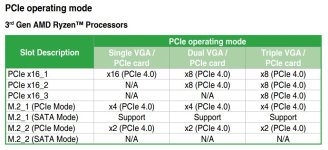It shouldn't be hard to understand. I need more lanes, without compromise, than is available from the current 'enthusiast' AM4 platform. I've said this more than once.
In reality it doesn't matter what i'm using and it's not me forcing the artificial limitations....the motherboards are. The PCIe bandwidths are not a substitute for lanes in all circumstances although people seem set on constantly conflating them. Your SM/enterprise-class example clearly shows that you gained benefit from PCIe4 because it unlocked the bandwidth you required. This isn't my use case. I require lanes and not bandwidth and PCIe4.0 will not change this.
I mentioned to you i have other >x1 cards and the reasons why it is not optimal to use. I'll humour you by letting you know that, among other things, i use a Perc H710 and as i alluded to i compromise my GPU by using it.
You had a bandwidth deficit here. I don't. This is an apples/oranges comparison so while it was interesting for me to read, offered nothing to my situation.
AMD designed a new IO chip, of course they could have added another 8 lanes while they were at it. Unless you have first-hand knowledge of what it took to design the IO die and why 8 lanes couldn't be added i'll file this statement under 'speculation'. What still remains is the fact they missed an opportunity to drive differentiation.
Harsh but true. Again, total bandwidth is not a substitute for available lanes (and vice versa). I also didn't lament having 990FXA for AM4, i lamented the flexibility of the large lane allocation. AMD could easily have done that while implementing PCIe3.0. It's a bit of a nonsense to bring PCIe2.0 up as if that's what i wanted.
At this point, PCIe4.0 is not a reason to buy for most people. Should AMD have brought out PCIE4.0 and more lanes than X370/X470 then i'd have bought, even at PCIe3.0. Not for the bandwidth, for the lanes. If AMD had brought out X470 but with an uplift from X370 in PCIe lanes then i'd have bought (where i didn't). See where i'm going with this? I don't think i'm unique in this regard.
You could use bifurcation and chop up a 16x slot.


